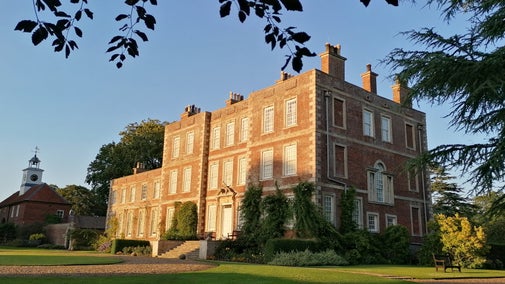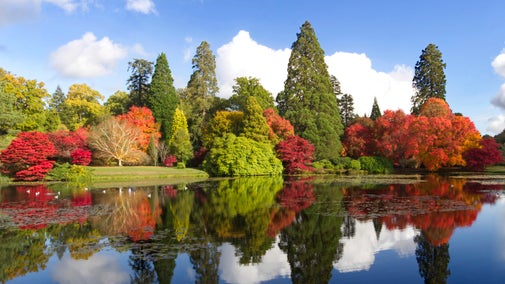Explore the Gunby gardens

Discover eight acres of different garden ‘rooms’ with many different colours and textures to enjoy. From sheltered walled corners to wildflower areas and sweeping lawns, the Gunby gardens offer something of interest throughout the year.
Tour of the garden
Sundial lawn
The little box-edged lawn with its central sundial was probably laid out in around 1900 by Margaret Massingberd, who also brought the little blue domed seat (now affectionately called the blue temple) from elsewhere in the gardens as part of her re-planning of this area. Honeysuckle is planted on either side of the seat and frames the view of the mixed herbaceous border on the other side of the lawn.
There are also cutting borders that run down to the greenhouses on either side of the pergola. The flowers grown are historically used for flower arrangements in the house. The square brick building nearby is a dovecote. This is as old as the house, possibly older, and houses a resident flock of white doves. You may spot them flying overhead.
Yellow border
Adjacent to the sundial lawn is the Yellow Border, a double herbaceous border featuring unusual plants such as Buphthalmum speciosum, a large-headed yellow daisy, Achillea ‘Cloth of Gold’ and Ligularia clivorum ‘Desdemona’, another daisy, but orange this time with leaves tinted with purple.
At the end, the arched gateway on the left leads past Kipling’s couplet, immortalised in stone, directly into the kitchen garden.
‘Our England is a garden, and such gardens are not made by singing, ‘O! How beautiful!' and sitting in the shade’
– Rudyard Kipling, ‘The Glory of the Garden’

Kitchen garden
Of all the areas of the gardens at Gunby, the kitchen garden has changed least in appearance and usage over time. Paths divide the garden into four main compartments which are recorded in Peregrine Massingberd’s plan of 1806, along with the linking perimeter path.
In the heyday of the gardens, and ever since, the four compartments and wall beds have been in vegetable production. A list, dated 1806, recorded fruit trees on the garden walls, which included: White Magdalen peach, brown fig, Chaumontelle pear, Temple Nectrine, Nutmeg Peach and Breda Apricot .
Today pears, plums, gages and figs cover the walls, with apples and more pears forming patterns down the central double herbaceous border. Flowers change from blues to oranges and red and back to blues and whites with the seasons.
Roses, a gift to Lady Montgomery-Massingberd in 1962, form the centre path. These include the Pemberton hybrid musk roses ‘Penelope’, ‘Cornelia’ and ‘Prosperity’ famous for their heavy scent, at its best in the cool of a summer’s evening.
‘It is this profuse combination of seasonable fruits and flowers…that invests Gunby with the air of a still living English country home’
– James Lees-Milne, Gunby Guidebook, 1946
Ghost walk
Instead of a wall on the south side of the kitchen garden, a yew hedge divides it from the carp pond. Irish juniper trees are dotted along the formal line of the walk, which is known as the Ghost Walk.
A young woman of the Massingberd family died after the murder of her stable lad lover by her infuriated father. Her ghost is said to walk here. The dying boy’s curse is supposed to be responsible for the remarkably few occasions in the history of Gunby that the succession has passed directly from father to son.
From here a path leads into the cherry walk, planted first in 1939. Only one of the original trees survives, a Pyrus malus, or apple tree. Re-planting has included a Great White Prunus serrulata ‘Tai haku’ which, in 1987, marked the sixtieth anniversary of the National Gardens Scheme, of which Gunby was an original supporter.
East lawn
The uninterrupted view of the east front of the house is framed by some fine specimen trees: a black mulberry, a Robinia and a Liquidambar, as well as a couple of cedars, all planted in the last couple of decades to provide succession to trees that have been lost during the twentieth century.
In the shrubbery to the left Rosa cantabrigiensis makes a show, with ‘Wedding Day’ clambering through the holly behind.
Behind this shrubbery there's a wildflower walk snaking along the park boundary. In season it's bright with winter aconites, snowdrops, crocuses and primroses. The carpet of wood anemones is particularly beautiful in March and April.
In 1904 a tennis lawn was created here due south of the house. On the East lawn, a pair of box-edged beds holds hybrid tea roses ‘Mrs Oakley Fisher’ and the heavily scented ‘Etoile de Hollande’. The planting of the great cedar of Lebanon was in 1812.
‘…and enable me to make pleasant shady walks for the summer all around the mansion. Nothing can be more charming and delightful than the prospect of so many pretty rising plantations…’
– Peregrine Massingberd, Journal entry 1812

Front garden
The current formal planting of a pair of parallel yew allées dates from 1902 with a stoned walk centrally leading to a sundial formed of a baluster from old Kew Bridge.
On the walls of the house ‘Sylvia’ and ‘Madame Butterfly’ fight for attention, whilst back in the courtyard the vigorous ‘Mermaid’, a single yellow rose, climbs up by the little gate in the corner and ‘Breeze Hill’, climbs happily on the clock tower opposite in big cabbage roses of pinkish apricot.
Picnics welcome
Picnics are welcome throughout the Gunby garden and grounds. Whether you like a sunny spot on the middle of the lawn at the back of the house, or a shady pitch under one of the many trees, there is lots of space for everyone at Gunby.
Well-behaved dogs on leads are welcome too throughout the garden, so the whole family can come along.
Stop by the tea-room to pick up ice creams, cake, crisps and hot and cold drinks to supplement your picnic.
Meet the Gunby cats
The Gunby gardens really belong to the resident cats called Fergus and Tabby. They are most often seen mooching about in the gardens. They love to meet everyone who is enjoying the outdoor spaces at Gunby.
You might also be interested in

Explore the Gunby estate
Find out more about the 1,500 acres of the Gunby Estate. Take a walk to discover an ice house pond, remains of a lost village and find evidence of a demolished medieval moated manor.

Visiting Gunby with your dog
With over 1,500 acres of grounds, Gunby is the perfect place to bring your dog. Find out all you need to know about making your visit an enjoyable one. Gunby is a two pawprint rated place.

Explore Gunby Hall
Explore Gunby Hall, which was home to the Massingberd family for over 250 years. The house features intimate living spaces filled with notable objects, artistic works, and homely décor.

History of Gunby Estate, Hall and Gardens
From a deserted medieval village to a charming red brick country house with Victorian extension, Gunby was home to the Massingberd family for over 250 years but the history of estate stretches back even further.

A family-friendly day out at Gunby Estate, Hall and Gardens
Entertain the whole family at Gunby. Discover unique stories in the house, go on an adventure in the gardens and stop for a bite to eat in the tea-room.

Gardens and parks
From 18th-century water gardens and Arts and Crafts landscapes to intimate woodland gardens, there are so many places to discover.

Gardening tips
Discover our gardeners’ top tips so you can make the most of your garden, plot or window box.

Gardens and parks in Nottinghamshire and Lincolnshire
Discover the historic gardens, parkland and historic pleasure grounds around Nottinghamshire and Lincolnshire, which are perfect for relaxing in and reconnecting with nature.